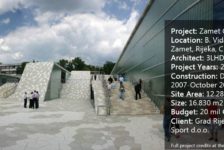Today’s Therapeutic Landscapes Network Blog guest post is by Amy Lindemuth, author of “Beyond the Bars: Landscapes for Health and Healing in Corrections,” a chapter in the forthcoming Greening in the Red Zone: Disaster, Resilience and Community Greening edited by Keith G. Tidball and Marianne E. Krasny.
Amy became interested in corrections after taking a series of undergraduate courses in medical anthropology at the University of Washington that focused on the culture of institutions and cultural constructions of health and mental illness. As a graduate student in landscape architecture, her interest in therapeutic landscapes and corrections led to a thesis project at the Monroe Correctional Complex in Monroe, Washington, designing a large courtyard garden for staff and inmates within a unit for mentally ill offenders. She also worked as a volunteer on the design and construction of a garden for mothers and their children at the Bedford Hills Correctional Facility in New York. These experiences gave insight into the concerns and perceptions of custody staff regarding green spaces in their facilities, and furthered her understanding of the cultural and psychological constraints unique to the field of corrections. Amy is interested in creating healthy, sustainable spaces that strengthen the social and ecological fabric of our communities. She practices in Seattle, WA. This is the first of two guest blog posts on the subject; we will publish the second post next week.
Can Prison Landscapes be Secure, Restorative, and Ecologically Sustainable? by Amy Lindemuth
Over the past several years, I’ve written articles [see the Therapeutic Landscapes Network’s References and Gardens in Prisons pages] about the need for landscapes in correctional facilities that provide therapeutic benefits or a restorative moment for corrections staff and inmates. For the most part, the views surrounding prisons and jails in the United States are bleak expanses of lawn, chain link security fences, walls and concertina wire, like the image above. Occasionally the view is broken by perennials planted near an administrative office or a vegetable garden in a secured area. This landscape typology evolved from the real need to keep staff, inmates, and the public safe from harm. Officer sight lines from station posts, towers, and other patrol locations throughout the grounds are unimpeded, allowing for quick identification of, and reaction to, disturbances or illicit behavior.
There are exceptions…
To read the rest of this post, link to the Therapeutic Landscapes Network Blog.
Published in Blog









